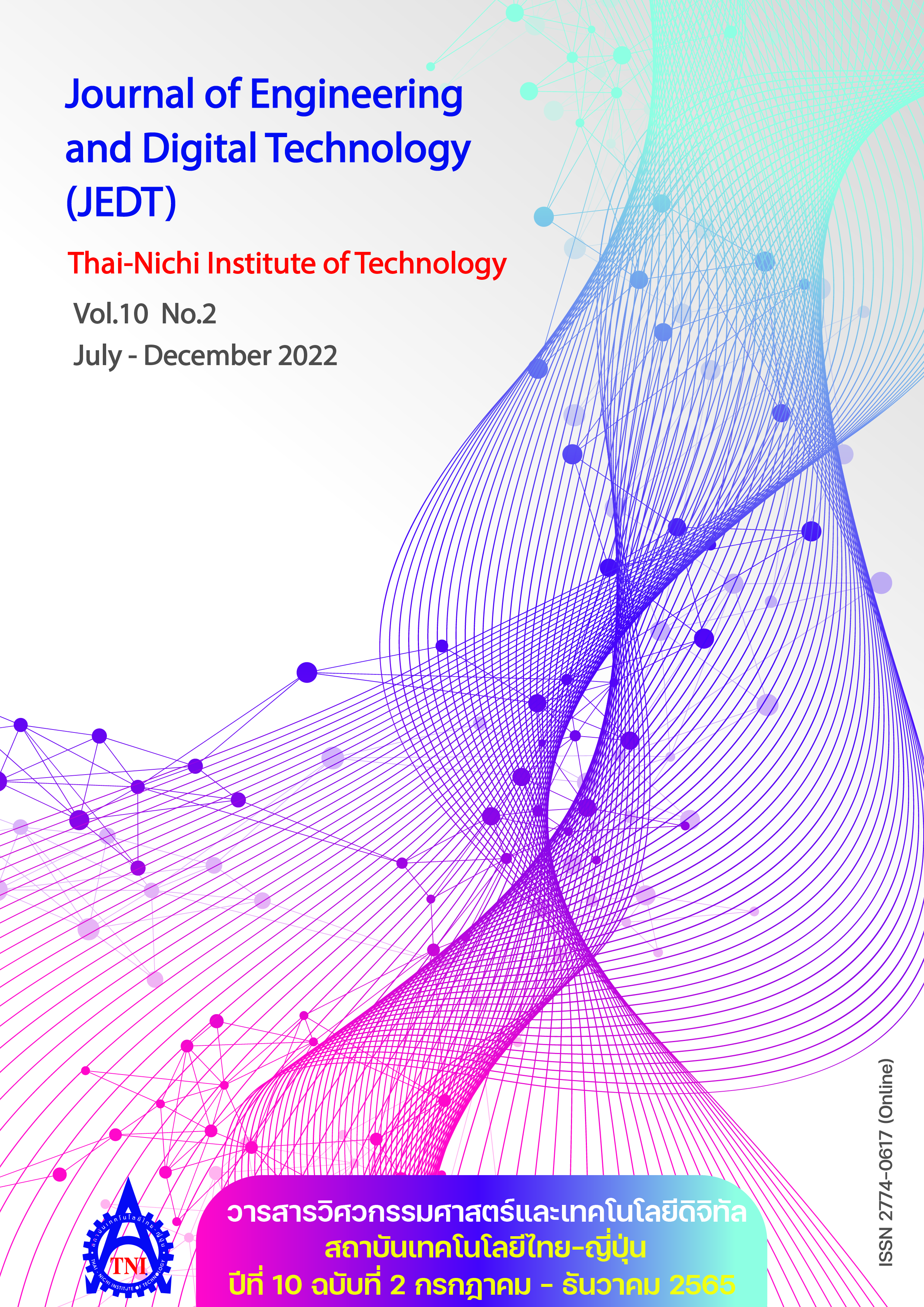การพัฒนากระบวนการสกัดชื่อภูมิศาสตร์จากข้อความทวิตเตอร์ด้วยแบบจำลองคอนดิชันนอลแรนดอมฟิลด์
Main Article Content
บทคัดย่อ
ระบบนำทางแผนที่ออนไลน์ทั้งบนเว็บบราวเซอร์ โทรศัพท์เคลื่อนที่ และแพลตฟอร์มอื่น ๆ ปัจจุบันมีความสำคัญขึ้นอย่างมากเนื่องจากการเพิ่มขึ้นของผู้ใช้งาน ผู้ให้บริการ โดยชื่อสถานที่หรือชื่อภูมิศาสตร์คือแหล่งข้อมูลสำคัญที่ผู้ใช้งานมักจะใช้เป็นคำสำคัญในการค้นหา รวมทั้งการจัดเก็บข้อมูลเหล่านี้ให้อยู่เป็นหมวดหมู่ต่าง ๆ ด้วย ซึ่งงานวิจัยนี้มีวัตถุประสงค์เพื่อสร้างแบบจำลองที่สามารถสกัดเอาชื่อภูมิศาสตร์พร้อมทั้งจัดหมวดหมู่แบบอัตโนมัติโดยมีแหล่งข้อมูลสำคัญคือสื่อสังคมออนไลน์จากทวิตเตอร์ซึ่งเป็นแพลตฟอร์มที่ได้รับความนิยมในประเทศไทยแพลตฟอร์มหนึ่ง เป็นแหล่งข้อมูลข่าวสารที่มีความรวดเร็วและมีการอัพเดตข้อมูลตลอดเวลาทำให้มีโอกาสพบกับชื่อภูมิศาสตร์ที่เป็นสถานที่ใหม่ ๆ ซึ่งเป็นประโยชน์กับการรวบรวมข้อมูลภูมิสารสนเทศโดยที่ไม่จำเป็นต้องออกไปสำรวจข้อมูลภาคสนามเพียงอย่างเดียว ซึ่งเครื่องมือทางด้านการรู้จำชื่อเฉพาะในภาษาไทยนั้นไม่สามารถนำมาใช้ได้โดยตรงเนื่องจากมีการแบ่งประเภทของชื่อเฉพาะที่ไม่ได้จำแนกหมวดหมู่ของชื่อภูมิศาสตร์ไว้ โดยในส่วนของงานวิจัยนี้นำเอาอัลกอริทึมคอนดิชันนอลแรนดอมฟิลด์มาประยุกต์ใช้ร่วมกับคุณลักษณะทางภาษา เช่น คำบุพบทที่แสดงถึงสถานที่ (ใกล้ ไกล ถัดจาก ถัดไป ฯลฯ) คำนำหน้า เช่น โรงเรียน ตลาด วัด หมู่บ้าน ฯลฯ ซึ่งในงานวิจัยนี้มีการสร้างคลังข้อมูลภาษา (corpus) ขึ้นมาจากข้อความทวิตเตอร์ จำนวน 28,082 ข้อความ แบ่งเป็นข้อมูลสำหรับฝึกสอน 22,445 ข้อความ คิดเป็นร้อยละ 80 และข้อมูลสำหรับทดสอบจำนวน 5,617 ข้อความ คิดเป็นร้อยละ 20 โดยออกแบบการทดลองออกเป็น 2 กลุ่มหลัก ตามอัลกอริทึมที่ใช้ในการตัดคำ ซึ่งผลการศึกษาแบบจำลองที่ให้ค่าความถูกต้องโดยรวม (F1) สูงที่สุดคือ 0.946 ซึ่งให้ความถูกต้องโดยรวมเพียงพอสำหรับการนำไปใช้งานในส่วนที่เกี่ยวข้องต่อไป
Article Details

อนุญาตภายใต้เงื่อนไข Creative Commons Attribution-NonCommercial-NoDerivatives 4.0 International License.
นโยบายการรับบทความ
กองบรรณาธิการวารสารสถาบันเทคโนโลยีไทย-ญี่ปุ่น มีความยินดีรับบทความจากอาจารย์ประจำ และผู้ทรงคุณวุฒิในสาขาวิศวกรรมศาสตร์และเทคโนโลยี ที่เขียนเป็นภาษาไทยหรือภาษาอังกฤษ ซึ่งผลงานวิชาการที่ส่งมาขอตีพิมพ์ต้องไม่เคยเผยแพร่ในสิ่งพิมพ์อื่นใดมาก่อน และต้องไม่อยู่ในระหว่างการพิจารณาของวารสารอื่นที่นำส่ง ดังนั้นผู้สนใจที่จะร่วมเผยแพร่ผลงานและความรู้ที่ศึกษามาสามารถนำส่งบทความได้ที่กองบรรณาธิการเพื่อเสนอต่อคณะกรรมการกลั่นกรองบทความพิจารณาจัดพิมพ์ในวารสารต่อไป ทั้งนี้บทความที่สามารถเผยแพร่ได้ประกอบด้วยบทความวิจัย ผู้สนใจสามารถศึกษาและจัดเตรียมบทความจากคำแนะนำสำหรับผู้เขียนบทความ
การละเมิดลิขสิทธิ์ถือเป็นความรับผิดชอบของผู้ส่งบทความโดยตรง บทความที่ได้รับการตีพิมพ์ต้องผ่านการพิจารณากลั่นกรองคุณภาพจากผู้ทรงคุณวุฒิและได้รับความเห็นชอบจากกองบรรณาธิการ
ข้อความที่ปรากฏภายในบทความของแต่ละบทความที่ตีพิมพ์ในวารสารวิชาการเล่มนี้ เป็น ความคิดเห็นส่วนตัวของผู้เขียนแต่ละท่าน ไม่เกี่ยวข้องกับสถาบันเทคโนโลยีไทย-ญี่ปุ่น และคณาจารย์ท่านอื่น ๆ ในสถาบัน แต่อย่างใด ความรับผิดชอบด้านเนื้อหาและการตรวจร่างบทความแต่ละบทความเป็นของผู้เขียนแต่ละท่าน หากมีความผิดพลาดใด ๆ ผู้เขียนแต่ละท่านจะต้องรับผิดชอบบทความของตนเองแต่ผู้เดียว
กองบรรณาธิการขอสงวนสิทธิ์มิให้นำเนื้อหา ทัศนะ หรือข้อคิดเห็นใด ๆ ของบทความในวารสารสถาบันเทคโนโลยีไทย-ญี่ปุ่น ไปเผยแพร่ก่อนได้รับอนุญาตจากผู้นิพนธ์ อย่างเป็นลายลักษณ์อักษร ผลงานที่ได้รับการตีพิมพ์ถือเป็นลิขสิทธิ์ของวารสารสถาบันเทคโนโลยีไทย-ญี่ปุ่น
ผู้ประสงค์จะส่งบทความเพื่อตีพิมพ์ในวารสารวิชาการ สถาบันเทคโนโลยีไทย-ญี่ปุ่น สามารถส่ง Online ที่ https://www.tci-thaijo.org/index.php/TNIJournal/ โปรดสมัครสมาชิก (Register) โดยกรอกรายละเอียดให้ครบถ้วนหากต้องการสอบถามข้อมูลเพิ่มเติมที่
- กองบรรณาธิการ วารสารสถาบันเทคโนโลยีไทย-ญี่ปุ่น
- ฝ่ายวิจัยและนวัตกรรม สถาบันเทคโนโลยีไทย-ญี่ปุ่น
เลขที่ 1771/1 สถาบันเทคโนโลยีไทย-ญี่ปุ่น ซอยพัฒนาการ 37-39 ถนนพัฒนาการ แขวงสวนหลวง เขตสวนหลวง กรุงเทพมหานคร 10250 ติดต่อกับคุณพิมพ์รต พิพัฒนกุล (02) 763-2752 , คุณจุฑามาศ ประสพสันติ์ (02) 763-2600 Ext. 2402 Fax. (02) 763-2754 หรือ E-mail: JEDT@tni.ac.th
เอกสารอ้างอิง
S. Kemp. “DATAREPORTAL.” DATAREPORTAL.com https://datareportal.com/reports/digital-2021-thailand (accessed Jan. 2, 2022).
S. Hahmann and D. Burghardt, “How much information is geospatially referenced? Networks and cognition,” Int. J. Geogr. Inf. Sci., vol. 27, no. 6, pp. 1171–1189, 2013, doi: 10.1080/13658816.2012.743664.
M. Gritta, M. T. Pilehvar, N. Limsopatham, and N. Collier, “What’s missing in geographical parsing?,” Lang. Resour. Eval., vol. 52, no. 2, pp. 603–623, 2018, doi: 10.1007/s10579-017-9385-8.
W. Phatthiyaphaibun, K. Chaovavanich, C. Polpanumas, A. Suriyawongkul, L. Lowphansirikul, and P. Chormai, “PyThaiNLP: Thai Natural language processing in Python.” 2016. Distributed by Zenodo. doi: 10.5281/zenodo.3519354.
J. Lingad, S. Karimi, and J. Yin, “Location extraction from disaster-related microblogs,” in Proc. 22nd Int. Conf. World Wide Web, Rio de Janeiro, Brazil, May 2013, pp. 1017–1020.
J. Wang, Y. Hu, and K. Joseph, “NeuroTPR: A neuro-net toponym recognition model for extracting locations from social media messages,” Trans. GIS, vol. 24, no. 3, pp. 719–735, 2020.
J. A. de Bruijn, H. de Moel, B. Jongman, J. Wagemaker, and J. C. J. H. Aerts, “TAGGS: Grouping tweets to improve global geoparsing for disaster response,” J. Geovis. Spat. Anal., vol. 2, 2017, doi: 10.1007/s41651-017-0010-6.
M. D. Lieberman and H. Samet, “Multifaceted toponym recognition for streaming news,” in Proc. 34th Int. ACM SIGIR Conf. Res. and Develop. Inf. Retrieval, Beijing, China, Jul. 2011, pp. 843–852.
J. R. Finkel, T. Grenager, and C. Manning, “Incorporating non-local information into information extraction systems by gibbs sampling,” in Proc. 43rd Annu. Meeting Assoc. for Comput. Linguistics, Ann Arbor, MI, USA, Jun. 2005, pp. 363–370.
R. Chasin, D. Woodward, J. Witmer, and J. Kalita, “Extracting and displaying temporal and geospatial entities from articles on historical events,” Comput. J., vol. 57, no. 3, pp. 403–426, Mar. 2014.
M. Sagcan and P. Karagoz, “Toponym recognition in social media for estimating the location of events,” in Proc. IEEE Int. Conf. Data Mining Workshop (ICDMW), Atlantic City, NJ, USA, Nov. 2015, pp. 33–39.
H. Chanlekha, A. Kawtrakul, P. Varasrai, and I. Mulasas, “Statistical and heuristic rule based model for Thai named entity recognition,” 2002. [Online]. Available: https://citeseerx.ist.psu.edu/viewdoc/summary?doi=10.1.1.295.7088
H. Chanlekha and A. Kawtrakul, “Thai named entity extraction by incoperating maximum entropy model with simple heuristic information,” 2004. [Online]. Available: https://citeseerx.ist.psu.edu/viewdoc/summary?doi=10.1.1.64.1449
N. Tirasaroj and W. Aroonmanakun, “Thai named entity recognition based on conditional random fields,” in Proc. 8th Int. Symp. Natural Lang. Process., Oct. 2009, pp. 216–220, doi: 10.1109/SNLP.2009.5340913.
S. Thattinaphanich and S. Prom-on, “Thai named entity recognition using Bi-LSTM-CRF with word and character representation,” in 4th Int. Conf. Inf. Technol. (InCIT), Bangkok, Thailand, Oct. 2019, pp. 149–154.
C. Sutton and A. McCallum, “An introduction to conditional random fields,” Found. Trends Mach. Learn., vol. 4, no. 4, pp. 267–373, Apr. 2012.
P. Chormai, P. Prasertsom, J. Cheevaprawatdomrong, and A. Rutherford, “Syllable-based neural Thai word segmentation,” in Proc. 28th Int. Conf. Comput. Linguistics, Barcelona, Spain, Dec. 2020, pp. 4619–4637.
L. Ramshaw and M. Marcus, “Text chunking using transformation-based learning,” in Proc. 3rd Workshop on Very Large Corpora, Cambridge, MA, USA, Jun. 1995, pp. 82–94.
A. Ekwonganan, “Identification of Thai and transliterated words by N-gram models,” M.S. thesis, Linguistics Dept., Chulalongkorn Univ., Bangkok, Thailand, 2005.


